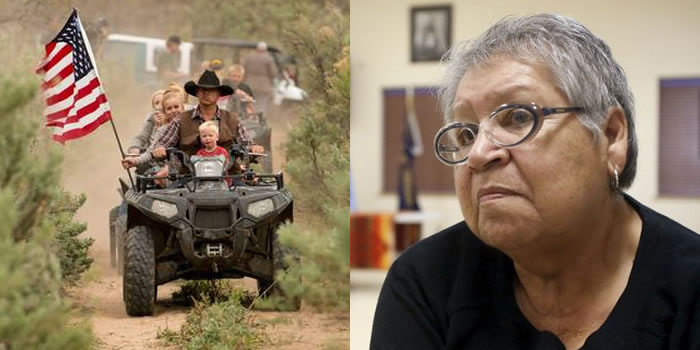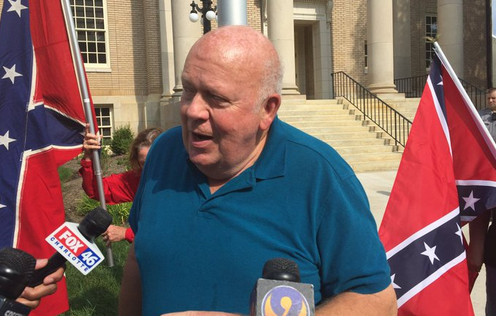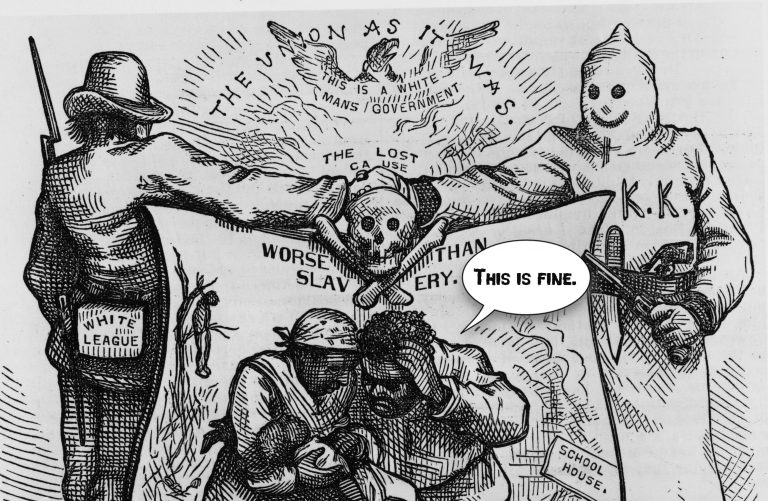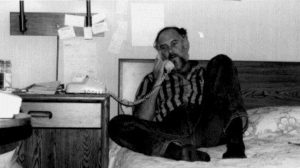This is the second installment in a three-part series that examines extremist elements connected to the takeover of the Malheur Refuge in Oregon. Part I focused on the long history of white supremacists in the ‘patriot’ militia movement.
In 2014, just weeks after Cliven Bundy’s trespassing cattle became a new rallying point for the so-called ‘patriot’ militia movement and galvanized the latest ‘land use’ uprising in the American west, his son Ryan showed up at Recapture Canyon with his family, his flag, and a four-wheeled ATV.
Bundy was taking part in an event organized by San Juan County Commissioner Phil Lyman and other local residents against the federal Bureau of Land Management (BLM), which banned motor vehicles from the canyon to protect Native American archaeological sites in 2007. At issue was a 7-mile-long, 4-foot-wide trail cutting through midden heaps, graves, home sites, and other artifacts of the Puebloan people who lived in that corner of Utah a millennium ago.
There are more than 2,800 miles of trails on BLM-controlled land available for off-road vehicle recreation around the town of Blanding, but Lyman and his local supporters were adamant about reopening this one, and they denounced the federal government for overreaching by not letting them ride it.
Meanwhile, Ryan Bundy and his friends had their own agenda. They were uninterested in Lyman or the people of San Juan County except as a recruiting pool for their own campaign against federal authority. Ryan Payne, the bearded Montana electrician who led the sniper teams at Bundy Ranch as they trained their weapons on BLM employees, declared as much to the Las Vegas Sun beforehand. “This is where it’s happening Saturday. This is a continuation of the Bundy affair.” More aggressive than his brother Ammon, Ryan Bundy had been an active part of the long-running ‘Sagebrush Rebellion’ since at least 1994; Lyman was organizing to challenge the law, but the son of Cliven Bundy was trying to break it.
“My fear is that this event is looking like conflict for the sake of conflict,” Lyman told the assembled crowd, which prepared to ride more than four dozen vehicles. Lyman wanted the trail riders to stop at the edge of BLM authority rather than continue into the forbidden zone: “I think we do more harm than good to actually cross that line today.” His sudden moderation proved highly unpopular. Investigative reporter Christopher Ketcham was on hand to witness the scene for Harper’s Magazine.
The Bundyites revolted. A woman shouted, “The BLM ruins the land!” There were denunciations of “the BLM police state” and comparisons to the Gestapo. There was talk of revolution. “You’ve got guns, too. By God, that’s what they’re for!” a man cried out.
Taking the microphone, Ryan Bundy also seized control of the event. “I came here to open a road, and if we aren’t going to do that, I’m going to get in my truck and go home. If we’re going to talk about public land, it’s not the public of the United States, it belongs to the public of San Juan County.” With a roar, the crowd ran to their jeeps and dirt bikes and four-wheelers, falling into a column. Lyman rode at its head, but he was obviously no longer in charge. Driving past the aforementioned limits, Lyman stopped at the end of a pipeline maintenance track while Ryan Bundy and members of his party rode on into more sensitive parts of the canyon, leaving the diminished organizer in a cloud of dust. Many of them carried semiautomatic rifles as if they were a wagon train of settlers expecting to be attacked by ‘savages’ at any minute.
Observing the scene remotely via pre-positioned cameras, the BLM did eventually prosecute five people, including Lyman, using social media photos of the event as well as their own surveillance images to make their case. Lyman and a blogger who had helped organize the trail ride were convicted, but Ryan Bundy and his friends were never even charged — a discrepancy which further emboldened their anti-government activity.
Also watching from a distance that day were local Navajo Indians, one group of whom were forced to cancel a traditional homecoming ceremony for military veterans. While the riders that day were uniformly Caucasians who only saw a favorite recreational area being kept off limits, Native Americans consider Recapture Canyon to be a sacred site.
Kenny Frost, a member of the nearby Southern Ute Indian Tribe, works as a consultant to educate the BLM and other agencies about the cultural significance of sacred sites. He pointed to parallels between the two protests and to conflicts over the rights to land.
“Basically we have people who are shying away from government control,” he said. “People who are saying this is public land and we can ride our ATVs wherever we please. We can ride them over ancient ruins because these people aren’t here anymore.”
Calling the BLM the “keeper of sacred sites,” Frost said the government has a duty to uphold all laws that protect archaeological evidence of the past. Laws apply even when sites are discovered inadvertently, he said—and even if the public must forfeit certain rights.
“We Natives have the right to protect people who were here long ago,” he said. “We fought to ensure our ancestors would not be disturbed.”
Former Navajo Nation Council Delegate Mark Maryboy told the Las Vegas Review-Journal that the ancient relics “are the equivalent to churches. It’s very disappointing that [the riders] have no respect for Native American culture.” He was specifically referring to the trail ride, but Maryboy could just as well have been talking about the disregard state leaders display towards his people. Native Americans are now a slim majority of the population in the area around Blanding, and the tribe has sued San Juan County for disenfranchisement after the most recent state redistricting somehow managed to leave a white majority on local councils in spite of these demographic changes.
Ethnic tension clearly plays a role in events at Recapture Canyon and informs riders’ attitudes towards the traces of history being smashed under their wheels. In recent years, white residents of the impoverished county — which suffers ten percent unemployment — have been unnerved and angered by federal enforcement of laws that protect Native American artifacts. Local ‘pot hunters’ often supplemented their incomes by supplying the black market for antiquities in the ‘tradition’ of their settler ancestors.
In a federal raid last month, more than 150 armed agents pounded on doors around town at dawn and rousted 16 residents. They had allegedly looted artifacts such as pipes, jewelry, stone knives and woven sandals and sold them to an undercover informant.
Those snared in the sting ranged from convicted drug users to some of the town’s most upstanding citizens. They were taken to Moab and charged, some with as many as four or five felonies, and all of them with at least one felony — violation of the antiquities act.
One of those charged was Harold Lyman, 78, the town founder’s grandson. A week before the raids, he was inducted into the Utah Tourism Hall of Fame. Another was a physician, Dr. James Redd. He killed himself a day after the raids. A week later, another of the raid’s defendants, a man from Santa Fe, committed suicide.
All of this recent history is prologue to the events at Malheur National Wildlife Refuge near Burns, Oregon, where Ryan Bundy and Ryan Payne were finally arrested this week after occupying the federal facility since January 2nd.
During their armed sit-in, the militants posted video of themselves rifling through thousands of Paiute artifacts curated at the refuge. Robert LaVoy Finicum, later shot dead during the arrest operation when he reached for a 9mm pistol, appeared in the video calling for a “dialogue” with the Paiute Tribe about the fate of the artifacts. Holding the camera, Stanley Blaine ‘Cooper’ Hicks was at least aware that the collection belonged to the tribe, but everyone in the scene appeared to be blissfully unaware that the Paiutes helped archive the items at the Malheur refuge in the first place. Not that it would have changed their minds: the entire discussion was aimed at clearing the materials out of the refuge to make way for whatever the militants thought they would build in place of a visitor center.
And that rebuilding was already underway. Using construction equipment housed at Malheur, Bundy’s militants also carved a road right through archaeological sites every bit as sensitive as those in Recapture Canyon. Reacting to the news, tribal chairwoman Charlotte Roderique expressed the feelings of her constituents to Indian Country Today Media Network.
I’ve gotten calls from ranching families who support the tribe. They’ve seen the [Paiute] campsites out there. They’ve been in that area and they know where things are. You can’t go and bulldoze things. I don’t know what these people are doing if they are doing things to just get a rise or to be martyr—all they are doing is making enemies out of the people they professed to support.
But for Native Americans, the most telling quote of the entire Malheur siege was Ryan Bundy dismissing the idea that the land he and his friends were supposedly taking from the federal government should revert to its original owners. “We also recognize that the Native Americans had the claim to the land, but they lost that claim,” he sniffed. “There are things to learn from cultures of the past, but the current culture is the most important.”
Whether he realized it or not, Ryan Bundy was voicing the nightmare scenario for Paiutes who worry that their cultural heritage stands to be erased. “That’s our history, our ancestors’ possessions and remains,” Rodrique told the Associated Press. “It’s hard to explain, as a native person, what that means to us. That’s the very proof of our existence in this country.”
No American minority group has suffered more from prejudice and racism than Native Americans. Historically, tribes have been reduced and even destroyed by enslavement, exploitation, ethnic cleansing, and internal deportation to rural ghettos (‘reservations’). Today, Native Americans are three of the top five age-and-ethnicity groups killed by police and suffer disproportionate incarceration. Children on reservations face daunting economic and educational barriers due to collapsing schools and scarce jobs in their communities.
Believing that he could win the Paiutes to his cause, Ammon Bundy expressed sympathy with the tribe over past oppression experienced at the hands of the federal government. But Rodrique refused to negotiate, instead referring to the gang at Malheur as “glory hounds” and pressing the Department of Justice to seal off the refuge to prevent militants from ‘pot hunting’ or making off with valuable artifacts. This is actually not a surprising turn, for despite all that they have suffered from Washington, the worst experiences of the Paiutes have always been at the hands of white settlers and ranchers.
Settlers first moved into what is now Harney County as late as 1862, years after settlers poured into western Oregon. Cattlemen then quickly began to take land or buy up homesteads to run their huge herds of livestock over the land. The limits of the native ecology were severely stressed due to the grazing of livestock by the expanding foreign population and the increase in hunting and fishing by those same people. Resources depended upon by the Paiute people were depleted or destroyed. But, as the Paiutes noticed, the settlers brought with them resources of their own–those very livestock and horses that were eating and trampling the Wadatika’s food supplies.
[…] Ranchers and homesteaders found common cause not just in their economic shared interests but, even more powerfully, in their opposition to the Paiute, who had made the basin their home for some thirteen thousand years. For all their differences, hating the Paiute gave ranchers and homesteaders a powerful sense of shared identity as whites. To lay claim to the basin for themselves, they believed they had to deny the Paiute’s claim to a home and physically expel them.
Since the 19th century, ranchers have been the most powerful lobby shaping American land use policy in the west even while their defiance of federal authority grew. As Ketcham recounts for Harpers, since World War II, the history of the region “is a chronology of ranchers’ resistance to federal regulation.” But now they have powerful new allies:
In 1979, following the passage of the Federal Land Policy and Management Act, which for the first time mandated environmental protection of territory controlled by the BLM, cattlemen pushed a law through the Nevada state legislature declaring that federal public lands were now the property of the state. They called it the Sagebrush Rebellion Act. The cattle barons styled themselves “sagebrush rebels,” and engaged in acts of defiance against the BLM, opening dirt tracks onto grazing allotments that had been closed, bulldozing new roads, overstocking their allotments, violating permit agreements, and refusing to pay grazing fees. As the rebellion spread, a conservative interest group called the American Legislative Exchange Council joined the fight. ALEC was founded in 1973 to craft “model legislation” for state governments; it brought together conservative state legislators and industry representatives in closed-door sessions. Copycat Sagebrush Rebellion Acts were passed in Utah, Arizona, Wyoming, and New Mexico.
[…] One week after the Bundy standoff, some fifty Republican state lawmakers, from nine Western legislatures, convened in Salt Lake City for what they called the Legislative Summit on the Transfer of Public Lands. The conference was organized by Ken Ivory, a Utah state representative, and Becky Lockhart, the speaker of the House in Utah: both are members of ALEC. Ivory had sponsored Utah’s Transfer of Public Lands Act, which was passed overwhelmingly by the state legislature in 2012. At the summit, Lockhart called the Bundy affair “a symptom of a much larger problem” — the problem being that federal public land exists at all.
ALEC is a ‘bill mill’ that acts as the legislative policy arm of the fossil fuel billionaire Koch brothers’ vast right wing network, which initially supported Cliven Bundy’s range war with the BLM. One of the model bills touted by ALEC, the ‘Eminent Domain Authority for Federal Lands Act,‘ cites the exact article, section, and clause of the United States Constitution that Cliven Bundy erroneously believes to prohibit federal government ownership of western lands. Ranchers, miners, and the oil and gas industry are keenly interested in leveraging the current ‘Sagebrush Rebellion’ to privatize federal lands, exploit and extract their resources, and ‘externalize’ their costs onto the backs of taxpayers.
Utah state representative and ALEC member Ken Ivory, who convened the Salt Lake City summit in 2014, is also the head of the American Lands Council. Claiming to be a ‘moderate’ organization, ALC has actively supported the cause of Dwight and Steve Hammond, the Harney County ranchers whose extended prison sentences were the ostensible catalyst for the Malheur refuge takeover. As the Institute for Research and Education in Human Rights revealed in a report last year, ALC sent Montana State Senator Jennifer Fielder to a conference of the happy-sounding Citizens Equal Rights Alliance (CERA) in Kalispell during September to spread the word about their scheme to devolve federal lands to the states, from where they can be put in private hands. Despite its innocent name, CERA is a hate group that focuses its bigotry on Native Americans.
The Wisconsin-based CERA is the most notorious organized anti-Indian group in the United States, dedicated to terminating tribal governments, abrogating treaties and turning management of tribal resources over to state government. ALC’s alliance with CERA again highlights the group’s ties to a broader far-right movement that threatens treaty rights, civil rights and environmental protection.
[…] The ALC’s proposed policies are of general concern to Indian Country because federal lands would be put in the hands of states often hostile to tribal interests and less committed to upholding treaty obligations than the federal government. Fielder’s outreach to anti-Indian activists amplifies this concern – suggesting, at the very least, greater scrutiny of the Lands Council’s claimed disinterest in tribal lands.
The American Lands Council’s ties to the organized anti-Indian movement do not end with Fielder’s CERA conference appearance. The ALC has, in fact, directly promoted CERA leader Elaine Willman’s writings and policy strategies. In a statement published on the ALC’s website, Elaine Willman writes, “I deeply support the mission and objectives of the American Land (sic) Council, and am so grateful for its existence and ongoing efforts.”
When the Malheur militants jabber about ‘freedom,’ they are actually demanding to be liberated from the constraints which protect other Americans from their exploitation. It remains to be seen what effect the breaking-up of the Malheur occupation will have on the larger movement, especially its most powerful and sinister elements. As exemplified by Ryan Bundy, the current iteration of the ‘Sagebrush Rebellion’ is just a modernization of the same white supremacy and ecological monopoly which nearly erased the American Indian from the Earth more than a century ago. This movement covets what little Native Americans have left — and threatens to crush the remaining traces of their cultures for fun and profit.














Thank you so very much for your very well-written and important articles! I’m Blackfoot and have been fighting this organized discrimination all my life. I live in Western New York on stolen Tuscarora land. Most people believe that people in the East are more enlightened and less racist than out west, but that is far from the case. In the 30 yrs. I have cared for this land as an organic farmer and seed saver of our ancient Native seeds, my family and I have been targeted by government and law enforcement. My children & I were shot at and my children nearly killed by a Secret Service agent named Romeo Brandani. Although he admitted in court that he did shoot at my children and home twice, his lawyer easily convinced the all white jury (they deliberated 10 minutes), that this man’s job was more important than our lives. He is presently the fire arms head trainer for the Secret Service. The local sheriff’s department hates me because I spent 15 yrs trying to protect a 10,000 yr.old communal burial site from destruction by mining. 186 acres of that burial were eventually destroyed for the American Rock Salt mine. Since then we have been targeted by local sheriffs who tasered and beat me up in my bedroom, giving me a concussion & other injuries and arresting my son who tried to help me. The police have made it clear that they refuse to take calls and arrest anyone who commits a crime against us. Without people like you calling attention to what we face as Native peoples, right now in 2016, all of our lands and the racism and abuse would be swept under the rug. Thank you again very much for your courage and your hard work!